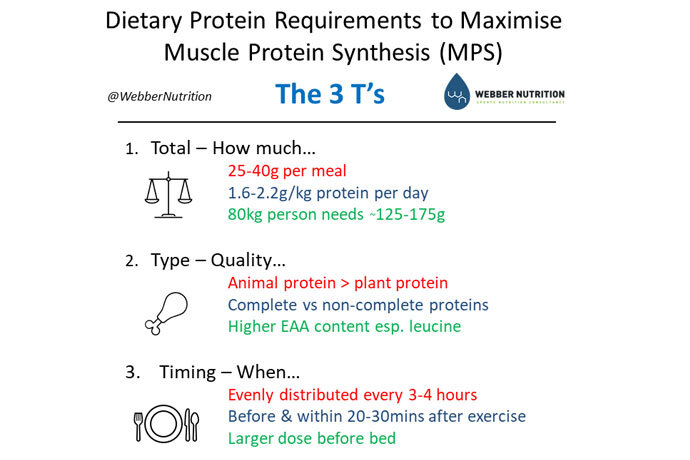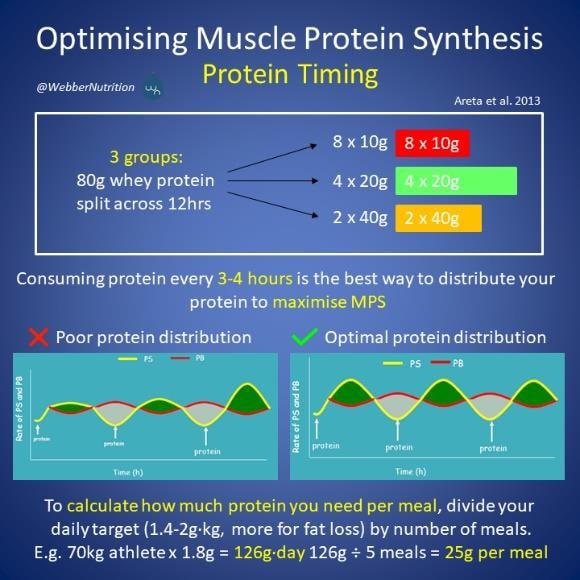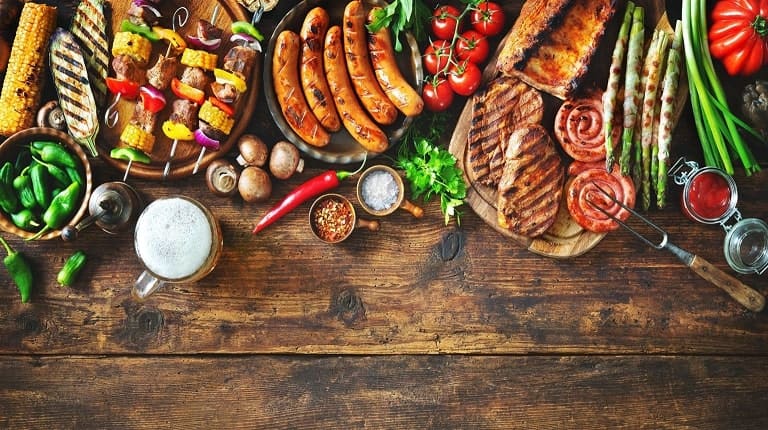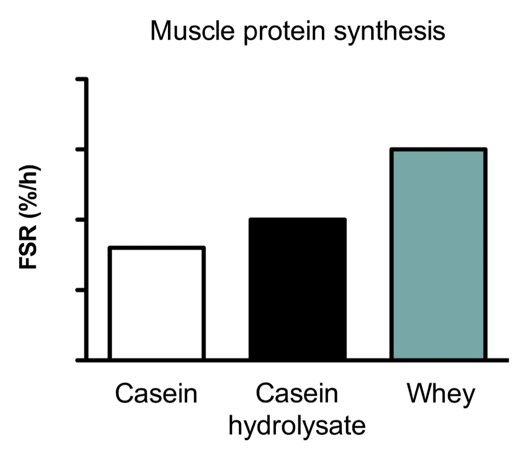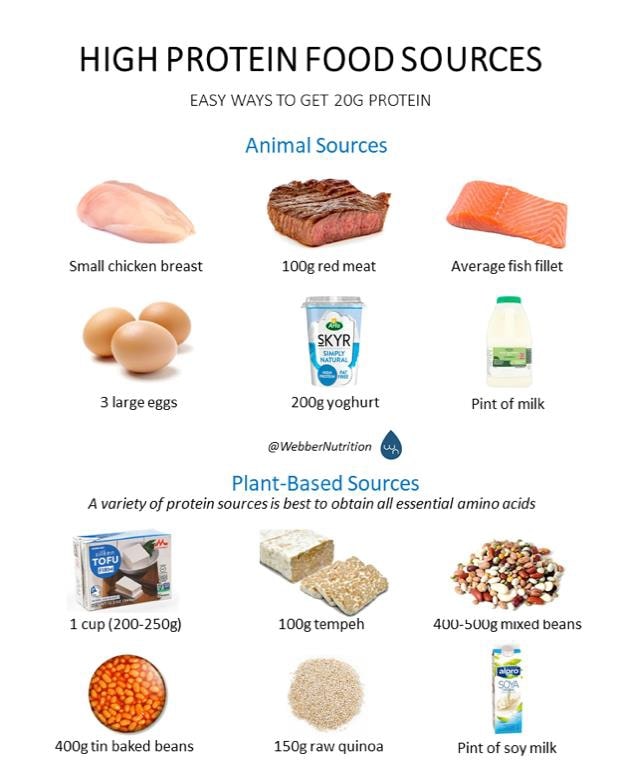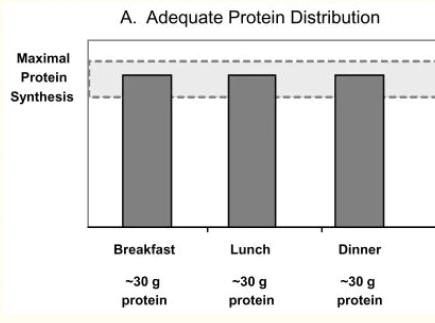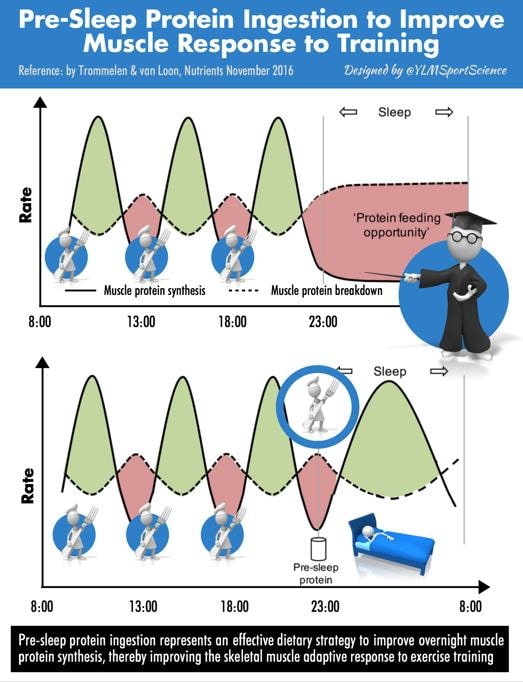Do you know how much protein you need? When looking at dietary protein intake, there are three important aspects you should focus on to maximise its effects on increasing muscle size, strength, and function. These are the total amount of protein you need to consume a day, the type of protein to consume, and the timing of which protein is consumed.
Part 1: Total – How much protein do you need?
The most significant of the 3 T’s is how much protein you eat each day. The recommended daily allowance (RDA), which has been defined as the average daily intake level, which is sufficient for the majority of people, is 0.8g/kg/body mass (bm) or 0.36/lb/bm (Phillips, 2014). However, the current literature supports that anybody who regularly undertakes resistance or endurance exercise greatly benefits from having more high-quality protein.
Resistance
Resistance-trained athletes habitually consume very high protein diets and can eat anywhere between 2 – 2.5g/kg/bm protein per day. It is evident from previous research that the increase in lean body mass during resistance exercise training is more incredible with increased total daily protein intake (Burke et al., 2001).
For example, a 100kg man, this means eating approximately 250g of protein every day, which is equivalent to eating 8 chicken breasts or 33 eggs! A high protein intake promotes muscle protein synthesis (MPS); a metabolic process of the incorporation of amino acids into the skeletal muscle proteins (Witard et al., 2021). When pairing resistance training and a high protein diet that promotes MPS it increases muscle gain as well as increasing hypertrophy and strength.
Additionally, when resistance training, athletes use their muscles more than the average person which will lead to fatigue therefore, more protein is required for recovery and to reduce the amount of fatigue.
Endurance
On the other hand, endurance athletes do not need as much protein but are recommended to consume between 1.6-2g/kg/bm per day. This is because an endurance athlete would probably consider the protein necessary to maintain lean body mass. If they consumed more it may lead to an increase in mass which may impair performance. Endurance athletes would still need more than the RDA for sedentary people as research has shown inadequate protein increases creatine kinase (a marker of muscle damage) (Jäger et al., 2017). Aside from obligatory uses, protein would be necessary for increased energy demands, protein synthesis of enzymes that are stimulated by endurance training, and repair of muscle proteins damaged by intense training.
High Intensity
The protein requirements for team-sport athletes who compete in high-intensity intermittent sports, such as football and hockey, is 1.8-2g/kg protein per day. This supports the combined endurance and strength/power-based training adaptations. In high-intensity sports, protein is important for MPS supports recovery processes, promotes satiety, and can aid the maintenance of body composition. Athletes with insufficient protein intake have an increased risk of muscle wasting, illness, and injury.
A study by Potgieter et al. (2014) suggests that greater intakes of protein such as 2.4g/kg/bm may be better suited in times when muscle hypertrophy is required e.g., the off-season. However, in seasons when athletes are required to meet training, competition, and recovery demands, dietary protein intakes should align with recommendations. Consuming protein after training is well-known to support recovery, by stimulating MPS to repair damaged tissue and promote training adaptations. 20g protein is sufficient for near-maximal MPS, with 40g offering slightly better results, but may only be beneficial for larger athletes (>100kg).
Consuming 20-40g protein soon after training based on your size & sport, as part of a daily intake of 1.8g/kg protein to optimally stimulate MPS so long as calorie intake is matched or increased for hypertrophy gains. A diet that contains insufficient protein during periods of training can result in a number of performance detriments including loss of lean muscle mass. For fat loss goals, increasing protein intake to 2-2.5g/kg can support the retention of lean muscle mass, with leaner and larger athletes requiring the upper limit to support their needs.
Age considerations:
Furthermore, the age of the athlete should be taken into consideration. Masters athletes over 65 years old may need more than 25 g per serving in order to stimulate maximum MPS, as they are less sensitive to protein and require a higher intake (Moore et al., 2015).
Part 2: Type – Protein-Rich Foods
After outlining how much protein is required to maximise MPS the next most influential element of protein intake is the type of protein. Protein is found in a wide range of food and it’s important that you get enough protein in your diet every day.
Protein needs can be easily met by eating a wide variety of protein-rich foods. Animal protein sources include meat, fish, eggs, and dairy products, whereas plant-based sources of protein include soya-based alternatives, i.e. tofu and tempeh, mycoproteins (Quorn), beans, lentils and other legumes, grains like quinoa, nuts and seeds.
Protein is made up of 21 amino acids, of which 12 can be naturally produced by the body whereas the remaining 9 cannot and are considered essential, and therefore must be sourced through the diet. Including protein-rich foods that contain all the essential amino acids (complete proteins) is important for maximising MPS. There is also the use of protein shakes/supplements to increase the amount of protein in the diet and therefore stimulate MPS.
However, the type of supplement differs in their ability to stimulate MPS the main properties that determine the anabolic effect of protein are its digestion rate and its amino acid composition. The two types of protein most commonly used as supplements are whey and casein protein.
Whey is a quick digesting protein whereas casein is slow digesting, and this will affect the rates of MPS as seen in the bar chart above.
BCAAs are also a very common supplement taken by bodybuilders to support MPS but are actually less effective than a whole protein source as mentioned above as they contain all essential amino acids (EAAs).
Leucine is one of the 3 amino acids that make up branched-chain amino acids (BCAAs) along with valine and isoleucine and is the key to activating the mammalian target of rapamycin (mTOR) which is the regulatory signaling pathway for MPS.
It is activated in a dose-dependent manner, so foods with a higher leucine content will activate mTOR better than low-leucine-containing foods. Peak plasma leucine concentrations following protein ingestion typically correlate with MPS (Pennings et al., 2011). This supports the notion that protein digestion rate and protein leucine content are important predictors of the anabolic effect of a protein source.
With a focus on leucine, rich food sources are the key to maximising MPS, such sources of protein include:
Animal Sources of Protein-Rich-Foods
- Meat
- Fish
- Eggs
- Dairy
- Whey and casein
Plant-Based Sources of Protein-Rich-Foods
- Quinoa
- Soy
- Mycoprotein (Quorn)
- Black beans
- Lentils
Proteins from animal sources typically have a higher essential amino acid content, especially leucine, and appear more potent than plant proteins to stimulate MPS (Van Vliet, Burd, and Loon, 2015). On the other hand, plant sources are typically lower in 1-2 EAAs, but this varies between each.However, there this can potentially be compensated by ingesting a greater amount of plant protein (Gorissen, et al., 2016). This means vegans should combine food sources to make sure their body gets enough of all the amino acids to stimulate MPS. Some examples include oats with a vegan protein powder, rice, and peas, or chilli made with various beans. Learn more about vegan diet pros and cons in detail.
Part 3: Timing of Protein Intake
Total & Type have been covered, now for the 3rd and final T for protein needs is the timing of protein intake. Firstly, the order of the three 3 T’s is actually based on priority for MPS. More protein is best, as the type of protein enhances those effects, and then distributing the protein will complete the set. Getting each of the 3 T’s correct will optimise your protein intake and show beneficial results. When to have protein is very important, and that’s why athletes should plan to consume protein within 30 mins after training because muscles are more sensitive to enhancing MPS. However, this is not the only time that protein needs to be prioritised.
MPS sensitivity is actually sustained for 24 hours after training, particularly resistance training which is essential for increasing muscle mass and strength. On the other hand, endurance exercise can cause a catabolic state and subsequent muscle protein breakdown, this enhanced absorption gives an opportunity to maximise protein intake in order to retain muscle mass following endurance exercise, for up to 24 hours (Tipton et al., 2004). So, this is why the total daily amount of protein is more important.
However, distributing protein intake can further enhance MPS. This can be done in multiple ways, for example, an even distribution of protein (3 meals of 30g) is better than skewed intakes such as 10g at breakfast, 15g at lunch, and 65g at dinner. Additionally, consuming 4 x 20g (every 3 hrs) would be better at increasing MPS than 8 x 10g (every 1.5 hrs) or 2 x 40g (every 6 hours). In regard to training, consuming 20-40g of protein within 60 mins after training would be beneficial as Burd et al. (2011) indicated that the combination of acute, exhaustive resistance exercise increases the muscle’s anabolic responsiveness.
Recent research into the use of protein before bed in both acute and long-term studies was found to be beneficial to MPS, muscle recovery, and overall metabolism 30 minutes prior to sleep and two hours after the last meal (Jager et al., 2017). 40 g of protein prior to sleep increases MPS during overnight sleep. Protein supplementation of 27.5g prior to sleep during a 12-week resistance training program improves muscle mass and strength gains (Snijders, 2015).
Additionally, older athletes, from around 50 years old, begin to gradually lose skeletal muscle known as sarcopenia. The loss of muscle mass is worsened by chronic illness, poor diet, and inactivity.
Therefore, it is crucial that older athletes meet their daily recommended protein intake to help them maintain muscle mass and strength. To maintain muscle mass, it’s important for older people to eat protein ‘effectively’. This means consuming high-quality protein foods as mentioned above.
Also, Learn more about Should I take protein supplements
Dietary Protein Intake Conclusion
Distribute your daily protein intake (TOTAL) that is made up of high quality, leucine-rich food/ supplement (TYPE), with each meal and snack throughout the day, across approximately 4-6 meals to support training times based on personal preference (TIMING)
Also Read: Protein Intake- The 3 T’s – Timing
References
Burd, N. A., West, D. W., Moore, D. R., Atherton, P. J., Staples, A. W., and Prior, T. (2011) Enhanced amino acid sensitivity of myofibrillar protein synthesis persists for up to 24 h after resistance exercise in young men. Journal of Nutrition, 141 (1), pp. 568–73.
Burke, D. G., Chilibeck, P. D., Davidson, K. S., Candow, D. G., Farthing, J. and Smith-Palmer, T. (2001). The effect of whey protein supplementation with and without creatine monohydrate combined with resistance training on lean tissue mass and muscle strength. International Journal of Sports Nutrition and Exercise Metabolism, 11 (1), pp. 349– 364.
Gorissen, S. H., Horstman, A. M., Franssen, R., Crombag, J., Langer, H., Bierau, J., Respondek, F. and Loon, L. J. (2016) Ingestion of Wheat Protein Increases In Vivo Muscle Protein Synthesis Rates in Healthy Older Men in a Randomized Trial. The Journal of Nutrition, 146 (9), pp. 1651 -1659.
Jäger, R., Kerksick, C. M., Campbell, B.I., Cribb, P. J., Wells, S. D., Skwiat, T. M., Purpura, M., Ziegenfuss, T. N., Ferrando, A. A., Arent, S. M. (2017) International Society of Sports Nutrition Position Stand: Protein and Exercise. Journal of the International Society of Sports Nutrition, 14 (20), pp. 230 – 237.
Moore, D. R., Churchward-Venne, T. A., Witard, O., Breen, L., Burd, N. A., Tipton, K. D., & Phillips, S. M. (2015). Protein ingestion to stimulate myofibrillar protein synthesis requires greater relative protein intakes in healthy older versus younger men. The journals of gerontology. Series A, Biological sciences and medical sciences, 70(1), 57–62.
Pennings, B., Boire, Y., Senden, J. M. G., Gijsen, A. P., Juipers, H. and Loon, L. J. C. (2011) Whey protein stimulates postprandial muscle protein accretion more effectively than do casein and casein hydrolysate in older men. American Journal of Clinical Nutrition, 93 (5), pp. 997 – 1005.
Phillips, S. M. (2014) A Brief Review of Higher Dietary Protein Diets in Weight Loss: A Focus on Athletes. Sports Medicine, 44 (2), pp. 149 – 153.
Potgieter, S., Visser, J., Croukamp, I., Markides, M., Nascimento, J. and Scott, K. (2014) Body composition and habitual and match-day dietary intake of the FNB Maties Varsity Cup rugby players. (ORIGINAL RESEARCH). South African Journal of Sports Medicine, 26 (1), pp. 35–43.
Snijders, T., Res, P. T., Smeets, J. S. J., Vliet, S. V., Kranenburg, J. V., Maase, K., Kies, A. K., Verdijk, L. B. and Loon, L. J. C. (2015) Protein Ingestion before Sleep Increases Muscle Mass and Strength Gains during Prolonged Resistance-Type Exercise Training in Healthy Young Men. The Journal of Nutrition, 145 (6), pp. 1178 – 1184.
Tipton, K. D. and Wolfe, R. R. (2004) Protein and amino acids for athletes. Journal of Sports Sciences, 22 (1), pp. 65 – 79.
Vliet, S. V., Burd, N. A. and Loon, L. J. C. (2015) The Skeletal Muscle Anabolic Response to Plant- versus Animal-Based Protein Consumption. The Journal of Nutrition, 145 (9), pp. 1981 – 1891.
Witard, O. C., Bannock, L. and Tipton, K. D. (2021) Making Sense of Muscle Protein Synthesis: A Focus on Muscle Growth During Resistance Training. International Journal of Sport Nutrition and Exercise Metabolism, 32 (1), pp. 49 – 61.


